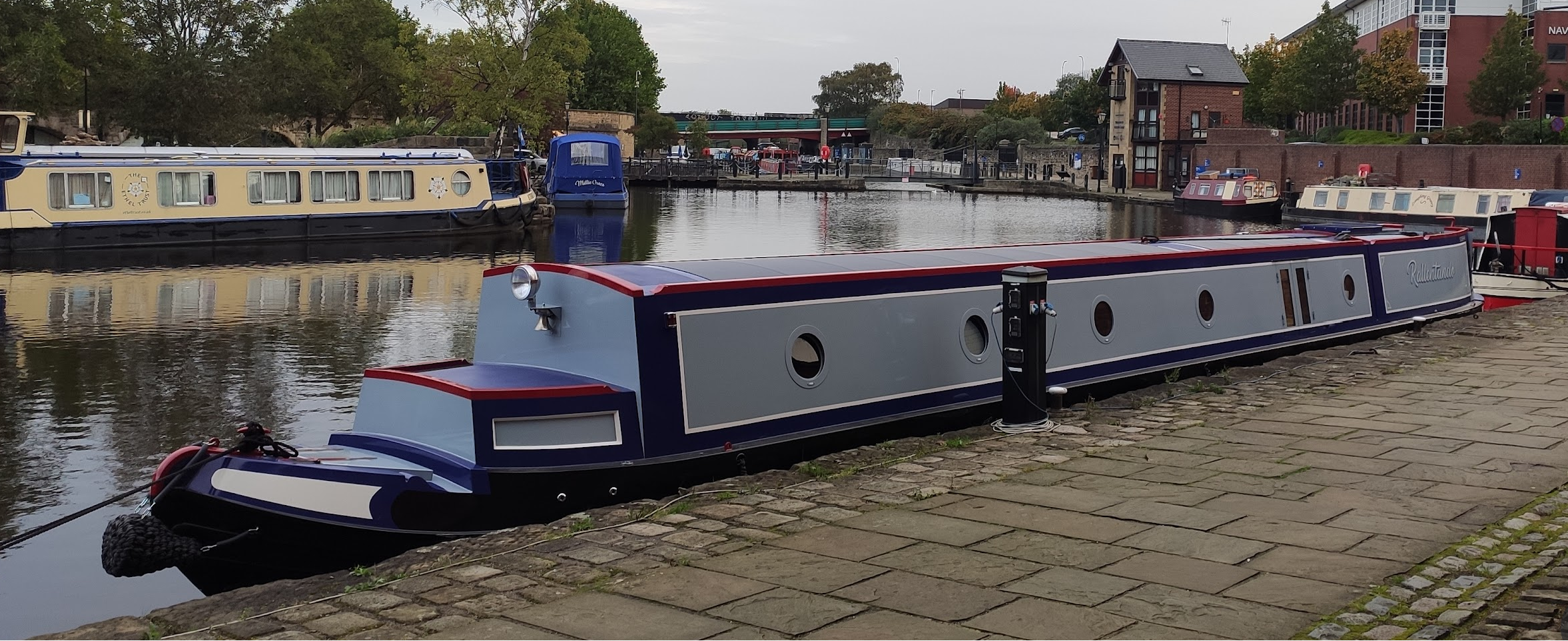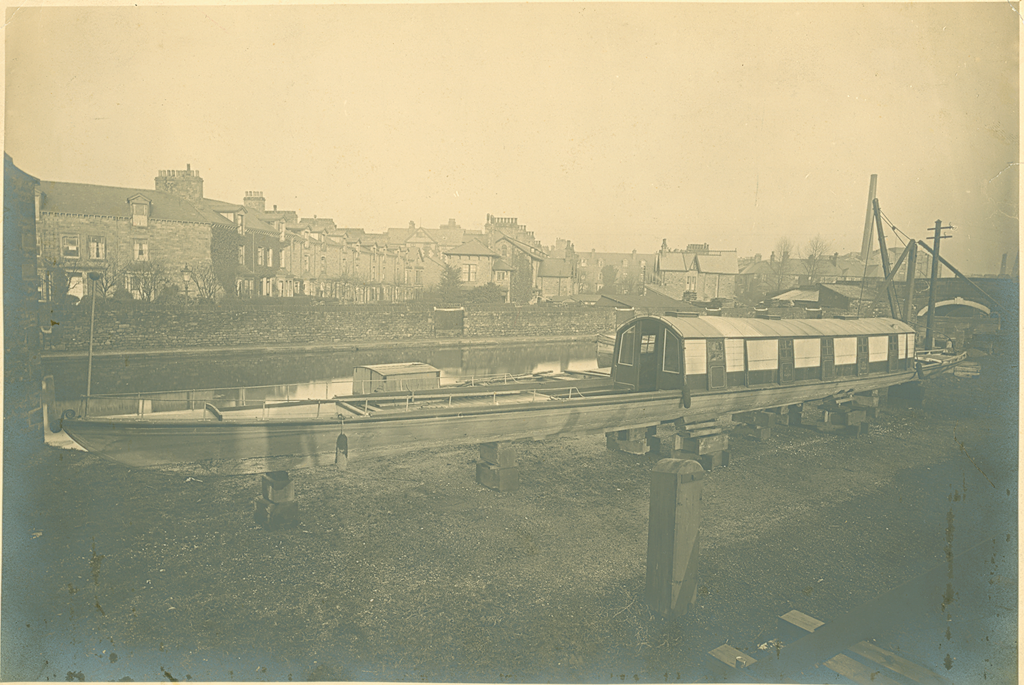-
Posts
15,877 -
Joined
-
Last visited
-
Days Won
117
Content Type
Profiles
Forums
Events
Gallery
Blogs
Store
Posts posted by IanD
-
-
8 hours ago, Francis Herne said:
The Euphrates Packet was scheduled for 2 hours to cover 9½ miles and three locks from Tipton to Birmingham, so a speed over 5mph.
This is making the error (like another thread recently) of assuming horses have 1hp, which is only about right if they're working constantly at a steady output all day.
Usable power of a horse depends on the duty cycle and packet boats often changed horses at quite frequent intervals. The figures I can find aren't great but I think you'd get in excess of 5hp per horse over an hour or so. Greater for a few seconds while accelerating which is where you really need it.
Given that the definition of 1hp was the output that a horse could sustain for extended periods -- meaning, all day -- while doing tasks like pulling a plough, I expect this would apply to pulling boats as opposed to running the Grand National, with much higher output for a few minutes... 😉
How fast the boat can accelerate is irrelevant, how fast the horses can pull it for several miles (at least half an hour) is what matters, and this will be closer to the sustained output of 1hp -- maybe a bit more, but certainly not the much higher figure that horses can generate in a race, which apart from exhaustion would lead to overheating if sustained for long periods.
The point is moot anyway -- actual evidence was provided which shows that lightly-built wooden flyboats on the Lancaster canal pulled by two horses (generating however much power they could!) could average 8mph (and peak above this to allow for locks), and that's the question that was asked... 🙂
-
8 minutes ago, BoatingLifeUpNorth2 said:
It’s all attention seeking, can’t people see it?
Really basic questions from a totally clueless person. An old man that can’t do anything, totally incompetent by the sound of things.
Useful post content: 0%
Ad hominem content: 100%
Troll probability: 100%
You're the one who keeps fanning the flames... 😉
-
Just now, haggis said:
No sign of an otter but have been watching dragon flies (? The electric blue ones ) along side the canal. I met a dog walker along side the new bit in water ( but not navigable) watching what looked like a very small mouse swimming round on circles. We had no idea what it was - too small for a vole.
Most probably damselflies -- we get lots of them around the pond here...
-
 1
1
-
-
40 minutes ago, beerbeerbeerbeerbeer said:
you’re too modest for your own good 👍
which makes for conversationhaving said that there’s a good Wikipedia page on John Scott Russell and his discovery of the phenomenon:
” I was observing the motion of a boat which was rapidly drawn along a narrow channel by a pair of horses, when the boat suddenly stopped—not so the mass of water in the channel which it had put in motion; it accumulated round the prow of the vessel in a state of violent agitation, then suddenly leaving it behind, rolled forward with great velocity, assuming the form of a large solitary elevation, a rounded, smooth and well-defined heap of water, which continued its course along the channel apparently without change of form or diminution of speed. I followed it on horseback, and overtook it still rolling on at a rate of some eight or nine miles an hour [14 km/h], preserving its original figure some thirty feet [9 m] long and a foot to a foot and a half [30−45 cm] in height. Its height gradually diminished, and after a chase of one or two miles [2–3 km] I lost it in the windings of the channel. Such, in the month of August 1834, was my first chance interview with that singular and beautiful phenomenon which I have called the Wave of Translation.“
Did you look that up on Google? 😉
-
9 minutes ago, dmr said:
Yes, but theres nothing like a bit of first hand experience.
Agreed -- I was having a little pop at the people who ticked me off for daring to suggest that there might be useful information out there on t'interweb... 😉
-
57 minutes ago, dmr said:
Goliath flatters me but I know nufin'. I have been slightly involved in looking at the acoustic implications of boat wake on smaller seagoing boats, but that's a very different thing.
You could always look it up on Google... 😉
-
1 hour ago, GUMPY said:
Now sold out 😟
That often happens with dirt-cheap Scancom deals on Amazon, move fast or you miss them...
-
15 hours ago, Alway Swilby said:
Does the Scancom EE pay in advance allow access to all bands? The 24 month unlimited one works out at £15 per month which is pretty good. Our EE contract is expiring in mid July so looking around atm.
Yes 🙂
15 hours ago, GUMPY said:If it's anything like the Scancom 3 SIM there are no restrictions.
Remarkable deal.
Despite my home broadband on 3 running until December 2025 I just spotted this SIM
With the extra 10% I was offered it's £67.50 for 500gb a month until November 2027.
That's under £2.50 a month.
Hopefully I can live with 500gb, that's over 16gb a day 🫣
It is a great deal if you're happy using Three.
If you prefer EE then there are still great deals from Scancom, but considerably more expensive than on Three... 😞
13 hours ago, Gybe Ho said:Is there a whip antenna available that has equivalent performance to the classic Poynting with its white plastic box design? I am looking for a 4G 2xMimo omni antenna.
When I say whip, I mean a single upright stick design.
The Poyntings must be effective because during my towpath walks I clock more Poyntings on boat rooftops than any other design by wide margin possibly 3 to 1. My beef with Poyntings is that they are obtrusive lumps, I suppose some black paint would help.
So far I am getting by with putting my mobile on the roof to get a decent signal and the phone is able to broadcast a wifi hotspot signal through the steel roof to my laptop below.
Several here:
https://www.3grouterstore.co.uk/product-category/4g-antennas/
https://www.3grouterstore.co.uk/product/fullband-colinear-mimo/
Or you could get one of the roof-mounting puck/fin-type antennas which are less obtrusive then the Poynting panels -- and probably work better when mounted close to a metal narrowboat roof too... 😉
-
16 hours ago, magpie patrick said:
Yes, but DMR might actually know rather than looking it up on Google
So you are basing everything on Duchess Countess, a fly boat or packet boat designed for a particular traffic on a particular canal? Duchess Countess is famous for one reason and one reason only - the vessel lasted until 1956 and was described by Tom Rolt, who actually saw it. Most of the fast boats never saw the age of photography, we have only the descriptions of the time to go off. Some did get photographed, such as the Lancaster boats.
The Lancaster boats advertised a 6am departure from Kendal and a 1pm arrival in Preston, which was double the speed of the coach on the same journey. Whilst this works out at just over 8 miles an hour, passengers disembarked and walked past Tewitfield Locks, and they certainly didn't cover the ground at 8mph for that bit! disembark, walk past the locks, embark again would certainly take half an hour (the gap is around 3/4 mile from top lock to bottom lock) and anyone who's managed such a group would probably allow anything up to an hour. The boats covering a little over 56 miles in six hours is rather closer to the stated 10mph average.
Rough calculation of a hypothetical boat?
What happens if you put the actual dimensions of one of these in? Horsedrawn please, no propellor - it's not just prop loss, the hydrodynamic is different when pulled from the bank
That boat does indeed have much finer lines than the Duchess Countess, and would obviously go faster... 🙂
Thanks for providing actual timings for the Lancaster canal flyboats (is that what the photo is of?) which backs up the 8mph (or maybe up to 10mph allowing for stops) claim -- so my speculation based on the Duchess Countess was indeed wrong 🙂
(and I'm perfectly happy to admit this, as always when actual facts are used to show this rather than opinion and shouting...)
Still nothing to show that they actually used solitons to achieve this speed though -- I would have thought this would have been reported (like in Scotland) if it was actually the case. Unless evidence shows otherwise... 😉
-
46 minutes ago, beerbeerbeerbeerbeer said:
Plenty of information out there to be easily found in a couple of minutes... 😉
https://the-gist.org/2012/07/how-a-scottish-naval-engineer-and-his-horse-discovered-solitons/
http://www.ma.hw.ac.uk/~chris/scott_russell.html
https://chalkdustmagazine.com/features/its-a-particle-its-a-wave-no-its-a-soliton/
"...eight or nine miles an hour...for a mile or two..."
-
33 minutes ago, booke23 said:
I've certainly read about the Lancaster canal flyboats/passenger boats that used to attain those speeds.
Yes....right under your nose it seems!
Yes it's a flyboat (the Duchess Countess). Did it go faster than normal? -- yes, obviously, it "reputably" reached 6mph. Did it use the soliton effect? -- probably not... 😉
If you ask the Vicprop calculator (for displacement hulls in deep water) how fast a flyboat like that pulled by 2 horses might go -- and assume 60' long x 6' wide x 1.5' draft (displacing only about 8 tons), and allow 3hp engine power into a prop (since 2 horses don't have any prop slip/loss) it comes up with 5.2mph, which is still not the 6mph alleged above.
To get the 7-8mph referred to in the newspaper article you'd have to use the soliton effect. Chances of the mythical 10mph -- nil... 😉
-
4 hours ago, magpie patrick said:
This is true, but if you look at the canals that were well known for fast boats (well known is a relative term here - well known to uber geeks who are also information sponges) they are, or were, canals with long, relatively straight and deep lock free levels - the Lancaster, The Shroppie, and the Union. No one in their right mind was going to try this on the southern Oxford!
One also has to remember that the canals were in much better condition then
My point is that someone here didn't believe these speeds of 10mph - they happened, not everywhere, but they did happen.
The only records I've seen of the soliton/wave effect being used are on the deep/wide canals in Scotland -- the Union Canal was mentioned earlier, and the Glasgow & Ardrossan in the snapshot above.
It's possible it might have been used elsewhere (e.g. on the wider/deeper English canals) but I can't find any record of it -- and if there isn't any, it's just speculation to say it was used there... 😉
(like pulling boats with tractors/light railway engines -- yes it was done but only rarely and not for very long)
Since it needs boats specially built for the job as well as two horses, it would be expensive to run this way (using solitons) and pointless unless a large part of the journey can take advantage of it. My guess is that the narrow/fast/light boats referred to didn't use it most of the time in England (if ever?) but they still travelled faster than normal by having lower drag.
Unless there's actual evidence to show otherwise... 😉
-
5 hours ago, beerbeerbeerbeerbeer said:
ace 👍now try keeping a freezer below -18 in this weather!
Mine have no problem maintaining -18C, both at home and on the boat. But they're proper domestic 230V freezers, not little 12V boat/caravan ones... 😉
-
1 hour ago, magpie patrick said:
The soliton wave was discovered by a fly boat on the Union Canal in Scotland, this wave lifted the boat and enabled these higher speeds.
The boat profile was different too - sometimes round bilge, sleeker than the typical cargo boat and certainly more hydrodynamic than the leisure brick of today.
Passenger Boats between Bradford and Bath on the K&A were referred to as "Scotch Boats" as they were bought from the Union Canal and were significantly faster than anything else.
However IIRC the soliton only works under very specific circumstances which you can hit if you're lucky on a given stretch of canal (fairly deep and wide, and at one specific speed!) where everything is "just so", but this isn't going to happen over large parts of a journey on normal UK inland canals. A bit like surfing the Severn bore and then saying you can use this on all rivers... 😉
There's a picture of an old fly boat hull in one of the books on my boat, and it has much finer lines than a normal narrowboat, is narrower and draws less water, so it'll slip through the water much more easily.
-
5 minutes ago, beerbeerbeerbeerbeer said:
and can last 50 to 100 years,apparently,
so when the magical power of the solar panel itself gives up the ghost in a few years I’ll still be able to dance on them panels with clogs on
Still? You can't do it now, so what's gonna change -- gravity?... 😉
Anyone who things ETFE-faced flexible solar panel will last 50 to 100 years has been ingesting something, possibly MDMA or another FLA... 🙂
-
30 minutes ago, jim mitchell said:
Aside from prop protection considerations is a deeper draft for the whole hull Needed - most of the 'lower half of the prop circle could be below the main hullline - a bit like an outboard hangs down? 🤔
The bottom of the prop is above the skeg -- which is level with the bottom of the hull -- in (almost?) all canal boats. Anything else risks major prop/shaft damage if the boat hits or gets hung up on the top cill of a lock.
So in practice, allowing for clearances and keeping the uxter plate underwater, the draft (at the stern) is normally at least 6" bigger than the prop diameter.
-
1 hour ago, Gybe Ho said:
In the absence of science I went to Perplexity.ai and read that the compartment wood flashover temperature is 300 to 600 degrees C at ceiling level.
I cannot see an insulated lined flue reaching that temp above the roof even in the event of a runaway combustion in the stove itself. My expectation is the external temp of a lined flu is touch safe hence their adoption in new build narrowboats inside the main cabin.
Since starting this thread I have been back on the roof (ouch hot), and experimenting with panel tilt angles. I now have a concern about tar deposits landing on the underside of the panel. It is a swanky new bi-facial model.
Bifacial panels -- swanky or otherwise -- will give very little extra output on the roof of a narrowboat (when they cover most of the width), for their extra output they rely on being in an array and having a white/light surface beneath/behind them (e.g. in an array) to reflect stray light onto the rear face.
-
 1
1
-
-
6 hours ago, Buddyandy said:
It's definitely cheap... 😉
Motor is far too high speed/low torque*** to drive a prop directly on a canal boat though, so you need to sort out reduction gearing -- frame, pulleys, bearings, thrust bearing from prop shaft -- which needs mechanical engineering skills and a metal workshop. I doubt that many people looking as such a kit have these... 😉
*** 29nm at 3400rpm for 10kW output -- and at 79% efficiency, which is *terrible*...
https://www.dold-mechatronik.de/BLDC-Motor-Brushless-DC-Motor-10kW-48V-Liquid-Cooled,-HPM10KL-48
-
4 hours ago, GUMPY said:
There are 4g routers that are 4x4 mimo, most of the higher end Huawei ones are.
Most 4g routers only bring one pair of antenna out to the sockets on the back so run in 2x2 when in a steel box even if they are capable of 4x4 the B818 does this as that only brings the low band out on to the external sockets.
Most 5g routers* only bring one pair of the 5g antenna out to the sockets on the back so if no 4g available on the internal antenna there is no 5g either.
This means that without modification and external antenna when enclosed in a steel box most routers do not give their best.
*I think the NR5013E is unique in the fact that it brings 4g and 5g antennas to the sockets.
No because that was my phone not a router. However it does show that on the same device 5g is not always that much better than 4g.
This is in a location where I can get workable 4g and 5g reception with NO antennas connected at all.
What you said about external antenna connectors is exactly the point I was trying to make; most "consumer" routers (including Huawei) don't have a good solution for external antennae, because hardly anyone uses them. The NR5103E is a rare exception, as are most of the "commercial/industrial" routers like the RUTX50, but these are invariably much more expensive.
If you've got a good signal but the data rate is limited by network congestion it won't make any difference whether you're on 4G or 5G.
-
3 hours ago, Russ T said:
I think a 3 unlimited everything sim is something different.🤣
I've had no problem with the 1p mobile sims either in the router and can still access the inclusive talk time minutes using an external handset. The SMS messages are also accessible, but you need to use the router interface to access them. However 1p mobile looks expensive compared to what @blackrose currently has (in terms of cost, anyway)
If you use big data every month then the Scancom pay-in-advance SIMs are cheapest. If you only need this when you're on the boat for shorter periods then the monthly 1pMobile SIMs are cheaper.
-
19 hours ago, Rob-M said:
On our recent trip I've found the NR5103E has not been as good as my B818 was at similar locations. The B818 I never bothered with an external antenna but the NR5103E seems to mostly require using external antenna to get any sort of usable signal.
I've only ever used the internal antennae when setting up, all I know is that it works very well with external ones. One reason may be that the NR5013E has 4 wideband internal antennae (according to the spec), which is why it works properly on all bands with a 4x4 MIMO external antenna. Other routers have multiple internal antennae tailored to different bands which may have more gain, but makes using external antennae a PITA -- as described earlier...
21 hours ago, GUMPY said:Which shows absolutely nothing about how good the router is at aggregation... 😉
For the benefit of others -- since I'm sure you're aware of it! -- the 5G network in the UK is almost entirely "NSA" (Non Stand Alone), which means that call setup and control and cell handover is done via a 4G connection, and then 5G is used for data transfer if it's available. That means the 5G routers have to be able to do simultaneous TX/RX on multiple 4G+5G channels to work at all, which means they have more parallel datapaths internally, which means they can (almost always!) aggregate more channels than 4G routers -- so even when only 4G is available they tend to give higher data rates where these channels are available. And of course when 5G is available they also usually give higher data rates, though not always in both directions. Many 5G routers are also 4x4 MIMO, most 4G ones are 2x2 MIMO, which can also increase data rate in many cases.
So in many cases a newer 5G router (especially 4x4 MIMO -- with suitable antenna!) will give higher data rate than an older 4G router, and better carrier aggregation is one possible reason. Not always, but often. Lots of test data out there to show this... 😉
-
3 minutes ago, GUMPY said:
Apart from the B818 which is very good at aggregation.🤔
It is, for a 4G router. Good 5G routers are better still though... 😉
-
16 minutes ago, GUMPY said:
But sometimes very necessary
I have gone from sub 2Mbps to over 60Mbps by just changing bands
Most modern routers do band aggregation, they'll combine whatever bands are available to maximise data rate -- mine (5G NR5103E) often uses two or three bands simultaneously. But sometimes band blocking will force a router to use a different tower with weaker signal but more bandwidth (higher data rate), especially on older 4G routers which aren't as good at aggregation... 😉
-
3 minutes ago, Russ T said:
[snip]
However, TBH, I f your system was working previously, the fault either lies with the ISP, or the network traffic. I think I would wait and see if it improves again.
I suspect the clue is "Everyone's on 3 around here but I'm not sure if that's because we're all misers." -- network congestion due to too many users all trying to do things like streaming TV at the same time, which is unlikely to get better... 😉
-
 1
1
-





Recommended treatment process for below waterline rust spots in an epoxy paint layer.
in Boat Building & Maintenance
Posted
No, just pointing out what you're doing is repeatedly personally attacking another member, which is of course against the forum rules... 😉